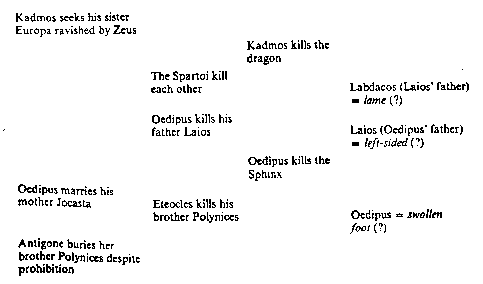
From "The Structural Analysis of Myth" by Claude Levi-Strauss
While classical dramaturgical analysis makes it possible to look at plays as quasi-symmetrical, quasi-fractal frameworks, it does little to help us understand internal symmetries and correspondences within works. For this, one must turn to structuralist analysis, developed by the French anthropologist Claude Levi-Strauss. Levi-Strauss posited that the human mind tended to create a "metastructure" by the pairing of opposites (good/evil, right/wrong, high/low, etc.) and that analysis of myths or cultures based on these groupings would reveal the key to their basic meaning.
In "The Structural Analysis of Myth", Levi-Strauss applies this method to the Oedipus myth using a matrix of 4 columns (see below) which, if read from left to right as one would read a book, charts the events or concepts of the play. The key, however, is to place similar events in the same column. Doing so creates a theme in each column and each item in that column is symmetrical to every other item in that column in that it is a manifestation of that particular theme in the myth. The items in the first column, for example, have as a common feature what Levi-Strauss calls the "overrating of blood relations," i.e. incest and brother-worship. The elements are symmetrical but also have a deeper structure in that their antitheses are contained in the second column, "the underrating of blood relations." The nested elements in column two are the negative image of column one and one might even say that the myth has a two-dimensional configuration space. This kind of layered structure has become known as "mythic structure" and the fact that it can be seen in everything from Brothers Grimm fairy tales to Star Wars illustrates to what extent our minds group objects, events, and even people according to patterns of similarity.

From "The Structural Analysis of Myth" by Claude Levi-Strauss
In the years since Levi-Strauss proposed a structural model for analysis, writers have become increasingly enamored with idea of embedding these structures in their works and have developed the concept of "mirroring." Film is perhaps the best example of this in that the "subplot" is often a reflection of the main plot onto a different plane, e.g. a raging war is mirrored in the relations of a husband and wife whose son is in the army. But modern writers and artists are not the first to consciously use this tactic. Again, the granddaddy is Shakespeare.
Shakepeare's plays are so full of mirrored elements that it is highly unlikely that they are merely a manifestation of the human mind's penchant for opposition and grouping. The Elizabethan concept of the Chain of Being allowed Shakepeare to fill his plays with mythic structures because it set up a direct line of god-heavens-earth-king-subject-animal and stated that events higher up on the Chain also played themselves out lower down. In King Lear, a storm roils as the wandering, bedraggled king's sanity finally snaps. In Hamlet, Horatio believes that the ghost "bodes some strange eruption to our state," just as:
|
In the most high and palmy state of Rome, A little ere the mightiest Julius fell, The graves stood tenantless and the sheeted dead Did squeak and gibber in the Roman streets: As stars with trains of fire and dews of blood, Disasters in the sun; and the moist star Upon whose influence Neptune's empire stands Was sick almost to doomsday with eclipse |
| -- Hamlet, Act I, sc. i |
Another construct employed by Shakepeare was the play within a play, which he used to great success in both TheTaming of the Shrew and Hamlet. He even goes so far as to give a prophetic nod to Levi-Strauss and his followers when, in the guise of a scheming Hamlet, he declares:
|
...any thing so overdone is from the purpose of playing, wheose end, both at the first and now, was and is, to hold, as 'twere, the mirror up to nature; to show virtue her own feature, scorn her own image, and the very age and body of the time his form and pressure... |
| -- Hamlet, Act III, sc. ii |
In the 20th century Shakespeare's technique exploded into the concept of "metatheater" and has been explored by Luigi Pirandello, Peter Handke and others who, armed with Levi-Strauss' methods, had become much more aware of a play's shape and form.
Page author: Max Dana